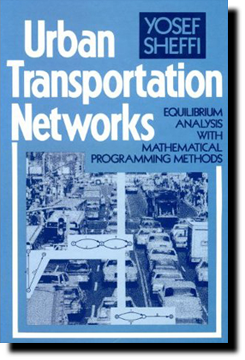- Risk Management

Preface: The flow pattern throughout an urban network can be looked upon as the result of two competing mechanisms. On the one hand, users of the system (drivers, passengers, pedestrians) try to travel in a way that minimizes the disutility associated with transportation. For example, motorists driving between a given origin and a given destination are likely to choose the route with the shortest travel time. On the other hand, the disutility associated with travel is not fixed but rather depends in part on the usage of the transportation system. Thus, in the previous example, the travel time on each of the paths connecting the origin and the destination is a function of the total traffic flow due to congestion.
It is therefore not clear a priori which path through the network has the shortest travel time. Consequently, it may not be obvious what the flow pattern throughout the network will be under various conditions. This book describes how this flow pattern can be determined for an urban road network by modeling these two mechanisms (travel decisions and congestion). The analytical approach described in this text draws on analogies between the two mechanisms mentioned here and the interaction of supply and demand in the marketplace. Instead of analyzing the price of a product and the quantity consumed, the analysis here looks at transportation level of service (or its inverse, travel disutility) and flows.
The results of the analysis include a set of flow and a set of level-of-service measures that are at equilibrium with each other. The book looks at many dimensions of travel choice, including the decision to take a trip, the choice of travel mode, the distribution of trips among various possible destinations, and the choice of route between an origin and a destination. All these decisions, when aggregated and analyzed simultaneously with the congested effects, result in the flow pattern through the network. The analysis of all these travel choices is carried out by using a unified framework that builds on graphical and network representation.
The problem of finding the equilibrium flow pattern over a given urban transportation network is also known as traffic assignment. The basic solution methodology is based on formulating the problem as a nonlinear optimization and solving it as such. This book, however, does not require any prerequisites in mathematical programming or graph theory. All the necessary background is reviewed at an introductory level. The level of mathematics assumed includes college calculus and (in the last parts of the book) introductory probability concepts. The book uses extensively intuitive arguments and network structures, which are utilized to illustrate many situations graphically.
This book grew out of a set of course notes used for two courses at M.I.T., one taken by graduate students and the other by undergraduates. Currently, the courses (and the notes) are combined, drawing both upper-level undergraduate and graduate students. The book was designed as a text for the following classroom environments: 1. A primary text for an intensive one-semester (or two-trimester) course(s).
2. A primary text for a slower one-semester or a one-trimester course (Chapters 1-6, 7, and/or 8, possibly 9, and parts of 13). Such a course would cover only deterministic equilibrium methods.
3. A supporting text in an introductory urban transportation planning course (Chapters 1, 3, 5, 6, and 7 with emphasis on the algorithms).
4. A supporting text in a course on operations research and mathematical programming techniques, demonstrating the applications of the methodology.
The book should also serve practicing transportation engineers and urban planners as a reference guide on issues of traffic assignment and urban transportation networks analysis.
Many people have contributed to the development of this book. Warren Powell of Princeton University and Carlos Daganzo of the University of California at Berkeley joined me in most of my research in this area. Joel Horowitz of the University of Iowa and Hani Mahmassani of the University of Texas at Austin helped in the preparation of the manuscript by commenting extensively on its early versions.
Useful comments were also provided by Brian Brademeyer, Stella Dafermos, Mark Daskin, Patrick Harker, Haris Koutsopoulos, Larry LeBlanc, Joffre Swalt, and all the students who took my networks course at M.I.T. during the years in which the manuscript was in preparation. The contributions of Karen and Jonathan are also greatly appreciated.